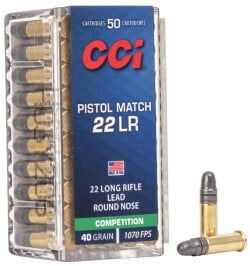
Most shooters have at least one 22-caliber rimfire firearm, whether they use it for plinking, hunting, competition or much more. That unmatched versatility makes such guns indispensable, but it can also lead to questions. For example, with so many options, some shooters wonder where to zero their 22s at the range. CCI ambassador Todd Jarrett says the answer depends on your gun, its sights and how you intend to it.
Plinking
“People want to go plink with their .22 rifles and pistols, and those are two different types of firearms,” says Jarrett, winner of several world Steel Challenge aggregate championships. “One is for long ranges, one is for short ranges, but folks also use them for defensive reasons.”
For .22 rifles with iron sights, Jarrett recommends shooters zero at about 20 yards.
“You can still see your target, you can still see your impact, and you can obviously shoot a good group with a rifle at that distance,” he says.
When zeroing a .22 rifle with a scope or red-dot sight, Jarrett extends that range.
Pistol Match
Settle for nothing less than flawless cycling in your rimfire handgun. Pistol Match uses precision components and tight tolerances to provide excellent accuracy, feeding and overall performance.
Buy Now
“I would recommend zeroing in at 50,” he says. “That gives you the joy and pleasure of knowing you’re able to hit targets out to 100 yards with your .22.”
Handguns
For .22 pistols with red-dot sights, Jarrett likes to zero at about 15 yards.
“I would consider that a long distance for people who want to go to the range and practice, but with a zero at 15 yards, that would be the longest distance you could potentially have for a defensive situation if you plan on using a handgun,” he says.
When zeroing .22 pistols with iron sights, Jarrett cuts that distance in half.
“With a semi-auto or a revolver, you might want to consider zeroing your gun in at the 7-yard line, depending on your skill and how you might approach that firearm,” he says. “If you’re inside 7 yards, an iron-sight firearm can be just as good as a red-dot because your complete focus will be on the target rather than if you’re shooting anything past that. I call it the point of no return. Past 7 or 8 yards, that’s where the advantage of a red-dot comes into play.”
When zeroing any .22 firearm with a red-dot, Jarrett says you should pay close attention to the size of the dot.

“If you’re looking for a defensive red-dot, my recommendation is a 6-minute dot or an 8-minute dot because it’s larger,” he says. “If you’re looking for precision and accuracy, especially on a rifle, I’d go with a 1- or 2-minute dot. You can compete with it and be precise when zeroing.”
Jarrett also says shooters who switch from traditional iron sights to a red-dot might initially have trouble finding the dot properly.
“You do not have to put the red-dot on your sight to see the red-dot,” he says. “The red-dot needs to be suspended in free air so you get to see that complete target. When zeroing a red-dot, I’ll zero my iron sights first. Once I do that, I will put the red-dot on the target so the red-dot is basically on top of your iron sights. Then you need to zero your red-dot to your red-dot. Now you have a true co-witness. If your sights are zeroed and your dot is zeroed, your dot can be suspended anywhere in that lens. It can be at 2 o’clock or 3 o’clock and your zero will be perfect every time.”
Due Diligence
And after every zeroing session, some routine maintenance will help ensure your gun functions well in the future.
“It’s important to clean your gun after each session,” Jarrett says. “If you shoot 50 to 100 rounds and you’re going to use it for hunting or defensive purposes, clean the chamber and barrel, and oil your firearm properly. Rimfires in general can be dirty. Owner beware. Make sure to clean your firearm.”